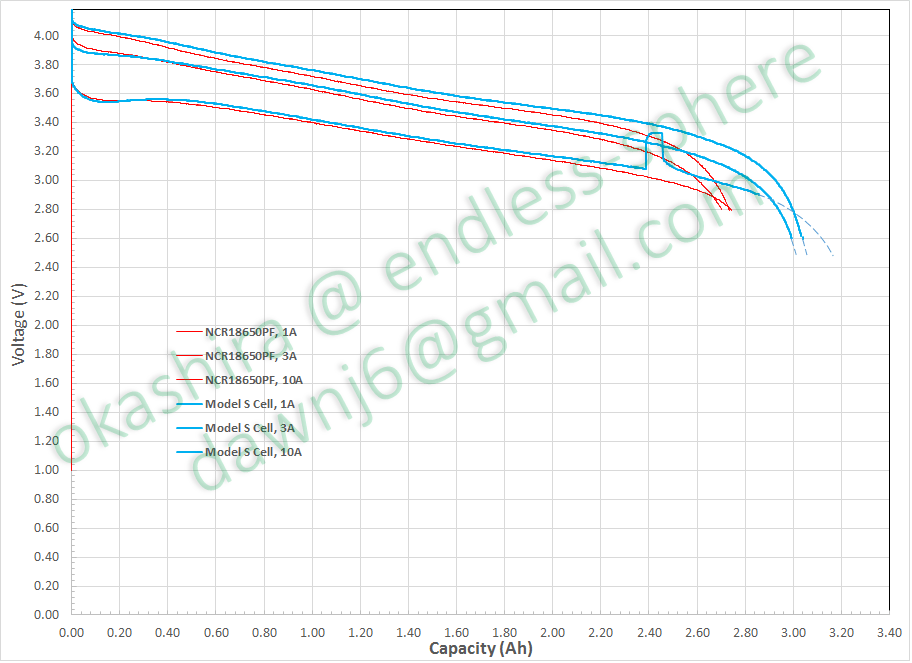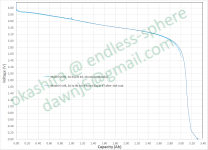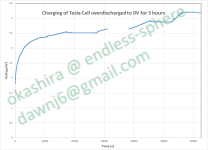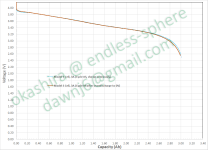okashira
10 kW
For those who are not aware, I have acquired (http://endless-sphere.com/forums/viewtopic.php?f=9&t=67661) a full Model S battery pack, that's basically in new condition. I have disassembled the pack and removed individual cells.
For your pleasure, I present the first individual cell test results seen publicly on the internet of Tesla Model S cells, using a 4-wire programmable DC load; cell was charged to 4.20V with a 50mA cut and let to rest for 45 minutes.
I will also update this thread soon with some in depth pics of the inner workings of the pack.
I included a common e-bike cell, a new(from fast-tech) Panasonic NCR18650PF (which is rated for 10A cont.) as a comparison.


(My annoying DC load stopped the 10A run at 2.9V for some reason, so I added some extrapolation [dotted line] based on prior tests to 2.5V.)
During the 10A run, I reduced current to 3A for 83 seconds to allow the cell to cool a bit. I did this to point out a couple of interesting, and quite useful performance characteristics of these cells:
-DCIR falls significantly at higher temperatures. This helps to self limit thermal build up of the... as the cell heats up, it tends to actually produce less heat!
-Panasonic NCA cells exhibit significant "surface discharge," that is, they perform well in bursts, where DCIR is lowered for a short period of time after a rest.
Here is a zoom of both effects:

-These cells would run great if bursted to 15A for ~5 seconds, we're talking nearly 50W from this tiny, very high capacity cell.
-Because they are so dense, they have ~350% of the energy capacity per volume when compared to LiFe cells, yet they can still compete fairly well with LiFe cells on a power/volume basis.
I would rate these cells at up to 10A continuous, for up to 12 minutes at a time from full charge, then reduce current to prevent overheating.
For your pleasure, I present the first individual cell test results seen publicly on the internet of Tesla Model S cells, using a 4-wire programmable DC load; cell was charged to 4.20V with a 50mA cut and let to rest for 45 minutes.
I will also update this thread soon with some in depth pics of the inner workings of the pack.
I included a common e-bike cell, a new(from fast-tech) Panasonic NCR18650PF (which is rated for 10A cont.) as a comparison.

(My annoying DC load stopped the 10A run at 2.9V for some reason, so I added some extrapolation [dotted line] based on prior tests to 2.5V.)
During the 10A run, I reduced current to 3A for 83 seconds to allow the cell to cool a bit. I did this to point out a couple of interesting, and quite useful performance characteristics of these cells:
-DCIR falls significantly at higher temperatures. This helps to self limit thermal build up of the... as the cell heats up, it tends to actually produce less heat!
-Panasonic NCA cells exhibit significant "surface discharge," that is, they perform well in bursts, where DCIR is lowered for a short period of time after a rest.
Here is a zoom of both effects:
-These cells would run great if bursted to 15A for ~5 seconds, we're talking nearly 50W from this tiny, very high capacity cell.
-Because they are so dense, they have ~350% of the energy capacity per volume when compared to LiFe cells, yet they can still compete fairly well with LiFe cells on a power/volume basis.
I would rate these cells at up to 10A continuous, for up to 12 minutes at a time from full charge, then reduce current to prevent overheating.





